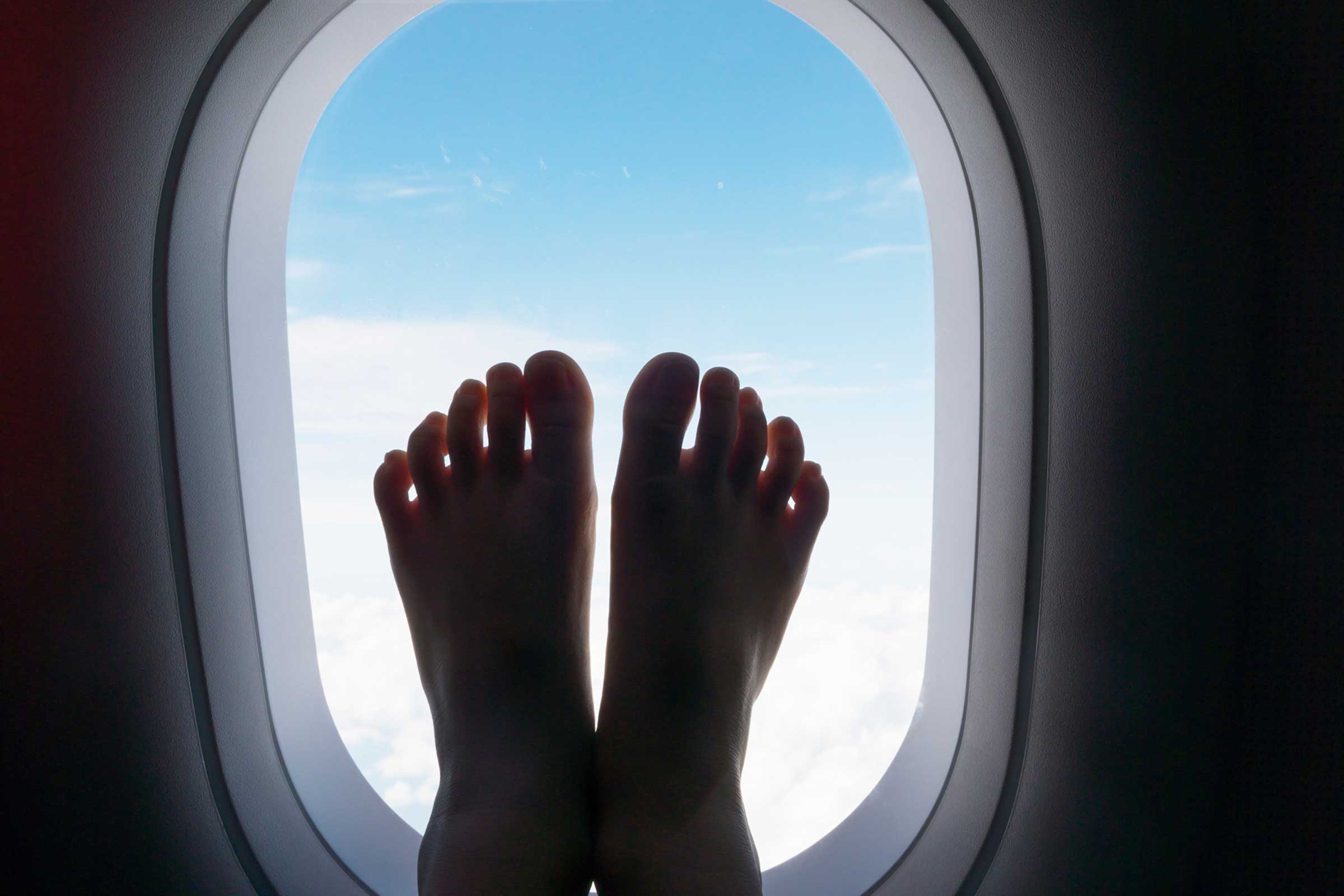Using accident statistics, plane travel is much safer than driving a car. The probability of dying in a plane accident is much lower than it is on a road trip. Still, even with the statistics, plane travel can be brutal on your body, particularly on long flights. Extended sitting, cabin pressurized air, and limited movement all contribute to a number of health issues, including elevated stress levels, dehydration, access to germs, ear pressure discomfort, bloating, and most significantly, deep vein thrombosis (DVT) risk increase, primarily in the legs.
In this article, we’ll concentrate on the effects of air travel on your feet and legs, and what you can do to maintain them in good health while flying.
What’s the Most Hazardous Spot on an Airplane?
In terms of health hazards on board, a window seat is not necessarily the ideal option. The American Illinois College of Physicians considered window seats as the most potentially dangerous due to circulation-related issues. This is since people seated by the window are less likely to shift their positions during the flight. Aisle seat passengers, on the other hand, are more likely to stand up and move around, naturally stimulating the blood circulation.
Staying still for hours, particularly in cramped seating, tends to make blood collect in the lower legs. At take-off, the body initially experiences pressure shifts that make the blood vessels constrict and slow down blood flow. Prolonged immobility also hinders circulation, causing swelling in the ankles and feet, and, in extreme cases, blood clots to occur.
Some travelers may be more at risk than others. Overweight, pregnant, elderly, and those on hormonal contraception are more likely to suffer from edema or vein thrombosis. Individuals with a past history of clotting disorders or cardiovascular disease should be extra cautious when traveling by air.
Preparation for a Flight
1. Diet Matters
To reduce your risk of leg swelling, begin acclimating your body a day before flying. Begin by cutting back on your sodium intake. Foods high in sodium, such as processed meats, fast food, canned vegetables, pickles, salty snacks, and even certain cheeses and sauces, can cause water retention that will lead to swelling.
Choose instead dishes that are high in potassium (avocados, sweet potatoes, bananas), which counterbalance water in the body. Also, drink plenty of water. Stay away from alcohol, coffee, and soda, since these contribute to dehydration and exacerbate in-flight bloating and tiredness.
2. Compression and Support
Wearing compression stockings is the best method for promoting healthy circulation on long flights. Wear them in the morning before your flight; they apply gentle pressure to the legs to promote blood flow upwards, keeping fluid from building up in the ankles and feet.
You might also want to try custom orthopedic insoles. They support your arches and promote natural movement of your feet, enhancing circulation. Shun pre-fabricated, one-size-fits-all insoles; each foot is unique, and the best insoles are those fitted by a foot doctor.
Feet Swelling Prevention Onboard
1. Keep Moving
After you board the plane, don’t wait for discomfort to creep in. Even small movements can have a significant impact. Attempt simple foot exercises such as:
- Toe taps: Lift and lower your toes while your heels remain on the floor.
- Heel lifts: Lift the heels from the floor while your toes remain fixed.
- Ankle rolls: Roll your ankles in a circular motion to enhance mobility.
- Foot pumps: Point and flex your toes repeatedly.
Strive to stand up and move around the cabin every 1–2 hours. This may be as easy as visiting the restroom or pacing up and down the aisle when allowed by the flight crew.
2. Raise Your Feet (If Possible)
If you get a row to yourself, use the chance to rest your feet up on the seats. Raising your legs even a little above the heart level decreases swelling and enhances venous return.
3. Massage and Stimulate Circulation
A light foot massage on the plane stimulates circulation and eases muscle tension. You may also use a little massage ball or get under your feet with a tennis ball to roll back and forth for a similar effect.
When to Visit a Doctor
In the majority of instances, swelling in the ankles and feet during a flight is benign and fades away within a couple of hours once you resume walking normally. Yet, if the swelling lasts more than a few hours, is painful, or is red and warm to the touch, it may be a sign of deep vein thrombosis (DVT), a condition in which blood clots develop in deep veins, typically in the legs. DVT is a serious medical condition and needs prompt evaluation.
Prior to flying, particularly for long-distance international flights, it’s advisable to see your doctor if you:
- Have a history of blood clots
- Are you pregnant or postpartum
- Take hormonal medications
- Have had recent surgery
- Have heart or vascular conditions
In certain situations, your physician might advise wearing medical-grade compression stockings or taking a low-dose blood thinner prior to the flight.
High-Risk Groups: Extra Factors
For people with cardiovascular problems, long flights can be more dangerous in the form of dizziness, fainting, angina attacks, or even heart attacks. Cabin pressure and lower oxygen levels at cruising altitude put a strain on the cardiovascular system. In these situations, it’s usually suggested to:
- Divide long travel into smaller chunks
- Pack essential medications in your carry-on
- Avoid sedatives or sleeping tablets that might hinder movement
- Notify the airline of your condition, particularly if aid is required when boarding or exiting
Final Thoughts
Flying need not be an injury to health, provided you take the necessary precautions. While it’s a fact that a long-distance flight can stress your body in one way or the other, your legs and feet are most at risk owing to minimal mobility. Small changes in lifestyle, including dietary changes, compression clothing, and exercises in-flight, can prove to be a turning point.
Safe travel begins with smart preparation. Keep moving, stay hydrated, and don’t ignore persistent symptoms — and you’ll be well on your way to a comfortable, healthy flight.











